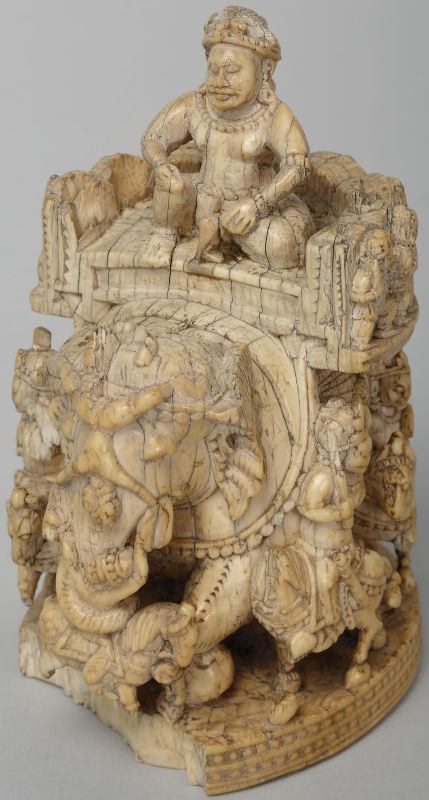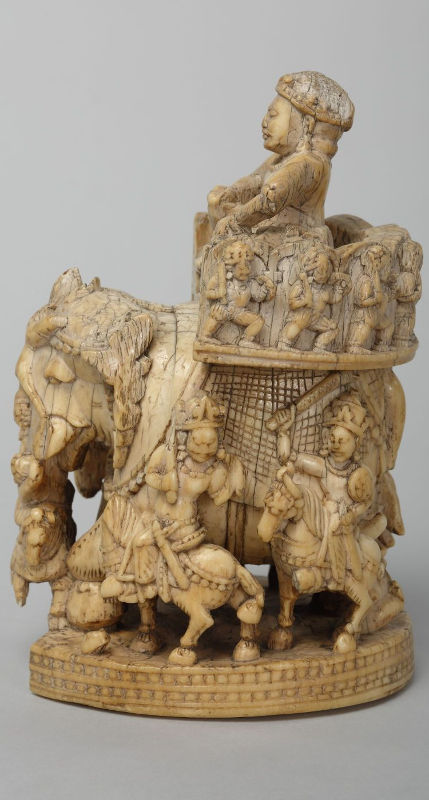Elephant from ‘Charlemagne's chess set’, Sind, India, 9th century
 A larger image of the Elephant from ‘Charlemagne's chess set’, Sind, India |  A larger image of the left side of Elephant from ‘Charlemagne's chess set’, Sind, India |
 A larger image of the Elephant from ‘Charlemagne's chess set’, Sind, India |  A larger image of the left side of Elephant from ‘Charlemagne's chess set’, Sind, India |
Désignation générale: pièce d'échecs, Eléphant de Charlemagne
Création / Exécution: Asie méridionale, Inde (lieu de création), 9e siècle
Matières et techniques: ivoire d'éléphant
Mesures: H. 15.5 cm, D. 8.9 cm
Description: L’éléphant est placé sur un socle arrondi dont la tranche est décorée d’une frise à deux rangs de perles. Autour de l’éléphant, quatre cavaliers, l’arme au poing. L’animal est orné d’éléments divers; on reconnaît sur le sommet de son crâne les éléments d’un personnage disparu, probablement le cornac. Sur le dos, l’éléphant supporte une plate-forme crénelée et ornée de huit guerriers en file; en son centre, un personnage richement paré est assis en tailleur.
Marques et inscriptions: sous le pied - inscription coufique - Traduction: “Oeuvre de Yusuf Al Bahili” (?)
Mode d'acquisition: saisie révolutionnaire
Donateur(s), testateur(s) ou vendeur(s): Trésor de Saint Denis
Date de l'acte d'acquisition: 18/1/1794
Ancienne(s) appartenance(s): Trésor de Saint Denis
Numéro d'inventaire: Inv.55.311
Autre(s) numéro(s): Chab.3271
Source: Médailles et Antiques de la Bibliothèque nationale de France
Referenced on p.67, EH - 071 - The Great Islamic Conquests AD 632-750 by David Nicolle
It took the Muslim Arabs, Iranians and Turks over a century to conquer what is now Afghanistan. This warlike region was ruled by a number of largely Buddhist local dynasties whose strongest cultural links were with India, as shown in this carved 8th or 9th century ivory chesspiece in the form of a war-elephant. (Cabinet des Medailles, Bibliothèque Nationale, Paris, France)
Referenced on p6, Armies of the Caliphates 862-1098 by David Nicolle
Cavalry fighting around a war-elephant with seated prince and his guards, probably from Sind 9th century (Bib. Nat. Cabinet des Médailles, inv. 311, Paris)
Referenced as figure 487 in The military technology of classical Islam by D Nicolle
487. Ivory chess piece, 9th century AD, Sindian or Afghanistānī, Bib. Nat., Cabinet des Medailles inv. 311, Paris (Du R).
p.69, see Maces, an extract from The military technology of classical Islam by David Nicolle
p.81: Throughout most of this period various forms of war-axe were being used by Muslim troops in the central and eastern regions. Although any apparent mention of the weapon in the 7th century may be an anachronistic insertion by a later copyists,85 there can be little doubt that axes had been widely adopted by ʿAbbāsid forces by the 9th and 10th centuries.86 It would, in fact, be particularly interesting to be able to date one Omani petraglyph that clearly shows a broad-bladed, short-hafted axe (Fig. 5), but although some work has been done on these sources no dating has yet been attempted.87 One of its nearest equivalents is to be seen in strongly Muslim influenced late 12th or early 13th century Sicily (Fig. 610G). Yet such axes are likely to have spread from Asia rather than from Byzantium. Two types may appear in 9th century eastern Islam a narrow-bladed axe with a spike at the back (Fig. 447) which was seen in this area around the time of the Muslim conquest (Fig. 442) and which may also be seen in a multitude of central Asian frescoes, and a broad-bladed weapon (Fig. 487) which may be of Indian origin88 and probably represents an early nāchakh.
85. Hill, "The Mobility of the Arab Armies in the Early Conquests," p. 116.
86. Leo, op. cit., Inst. XVIII; Al Khāṭib al Bagdādī, in Vasiliev, Byzance et les Arabes, vol. II, p. 78; Hilal al Sabiʿ, in Sourdel, op. cit., p. 141; al Jāḥiẓ, Rasa'il al Jahiz, pp. 19-20.
87. R. Jäckli, Rock Art in Oman, (Zug 1980).
88. Mubārakshāh, op. cit,. p. 272.
Fig. 5. Petroglyph, undated, ʿUmānī, in situ, Wādī Bahla, Oman, (Jac).
Fig. 610G. Manuscript, G - 'Weapons aboard a ship with a Muslim crew,' Chronicle of Peter of Eboli, early 13th century AD, Sicilian or south Italian, Bürgerbib., Cod. 120, f.119. [Departure of the captive Empress Constance d'Hautville for Messina.]
Fig. 447. Silver dish, 9th-10th centuries AD, Transoxanian or Khurāsānī, Hermitage, Leningrad (Gor D, Knob).
Fig. 442. Silver dish from Kulagysh, 7th-8th centuries AD, Khurāsāni or Transoxanian, Hermitage, Leningrad (Thor As Ric A).